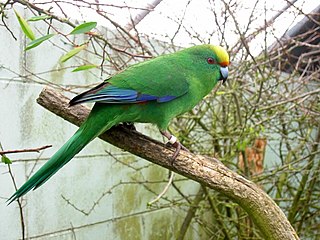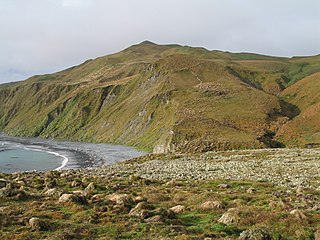
Platycercinae is a subfamily of birds belonging to the family Psittaculidae that inhabit Oceania. It consists of two tribes, the ground parrots and allies (Pezoporini) and the many species of broad-tailed parrot (Platycercini).

A broad-tailed parrot is any of about 35–40 species belonging to the tribe Platycercini. The members of the tribe are small to medium in size, and all are native to Australasia, Australia in particular, but also New Zealand, New Caledonia, and nearby islands.

The three species of kākāriki, or New Zealand parakeets, are the most common species of parakeets in the genus Cyanoramphus, family Psittaculidae. The birds' Māori name, which is the most commonly used, means "small parrot". The etymology is: from kākā, parrot + riki, small. The word is also used to refer to the colour green because of the birds' predominantly green plumage. The patches of red on the birds' rumps are, according to legend, the blood of the demigod Tāwhaki.

Cyanoramphus is a genus of parakeets native to New Zealand and islands of the southern Pacific Ocean. The New Zealand species are locally called kākāriki. They are small to medium-sized parakeets with long tails and predominantly green plumage. Most species are forest dwellers, although several of the subantarctic species live in open grassland. The genus formerly had a widely disjunct distribution; while most of the genus ranged from New Caledonia to Macquarie Island, two species were found in the Society Islands, 4,100 km (2,500 mi) away from the rest.

Malherbe's parakeet is a small parrot endemic to New Zealand, where it is known as the orange-fronted parakeet or orange-fronted kākāriki. In the rest of the world it is called Malherbe's parakeet, as when it was recognised as a species, the name "orange-fronted parakeet" was already used for Eupsittula canicularis, a Central American species. Restricted to a few valleys in the South Island and four offshore islands, its population declined to around 200 in the 1990s, and it is considered critically endangered by the IUCN.

The Antipodes Subantarctic Islands tundra ecoregion, within the tundra biome, includes five remote island groups in the Pacific Ocean south of New Zealand: the Bounty Islands, Auckland Islands, Antipodes Islands and Campbell Island groups of New Zealand, and Macquarie Island of Australia.

Ewing Island is an uninhabited island, part of the Auckland Islands group, a subantarctic chain that forms part of the New Zealand outlying islands. It lies in the north-east of the group, close to the mouth of Port Ross, immediately to the south of the larger Enderby Island and off the north-eastern tip of the main Auckland Island.

The Antipodes parakeet or Antipodes Island parakeet is a parrot in the family Psittaculidae that is endemic to the Antipodes Islands of New Zealand. It is one of two parrot species found on the islands, and one of only five ground-dwelling parrots in the world. They are long-living birds that may live up to 10 years of age, but the introduction of mice that compete with them for food was a threat to their survival on the Antipodes Islands until the mice were successfully eradicated from the Islands in 2016. Unusually for parrots, they sometimes prey upon other birds, a trait shared by another New Zealand parrot, the kea.

The red-crowned parakeet, also known as red-fronted parakeet and by its Māori name of kākāriki, is a small parrot from New Zealand. It is characterised by its bright green plumage and the red pattern on its head. This versatile bird can feed on a variety food items and can be found in many habitat types. It used to be classified as near threatened as invasive predators had pushed it out of its historical range but it is now at least concern. This species used to occupy the entire island, but is now confined to only a few areas on the mainland and some offshore islands.

The Raiatea parakeet or Society parakeet, also known as the Society kakariki or brown-headed parakeet, is an extinct parakeet of the genus Cyanoramphus.

The Chatham Islands parakeet, also known as Forbes' parakeet, is a rare parakeet endemic to the Chatham Islands group, New Zealand. This parakeet is one of New Zealand's rarest birds and is classified as Vulnerable on the IUCN Red List, as a result of a range of threats to the species survival, including habitat loss, predation, and hybridization. A number of conservation methods have been employed to assist the recovery of this species, and currently the population trend is considered stable.

The Norfolk parakeet, also called Tasman parakeet, Norfolk Island green parrot or Norfolk Island red-crowned parakeet, is a species of parrot in the family Psittaculidae. It is endemic to Norfolk Island.

The New Caledonian parakeet, or New Caledonian red-crowned parakeet, is a species of parrot in the family Psittaculidae. It is endemic to New Caledonia. The species was once considered to be conspecific with the red-fronted parakeet of New Zealand but is now considered a full species and is known to be the basal species in the genus Cyanoramphus, which had its origins in New Caledonia.
The Macquarie parakeet, also known as the Macquarie Island parakeet, is an extinct subspecies of the red-crowned parakeet from the subantarctic Macquarie Island, an outlying part of Tasmania, Australia, in the Southern Ocean.

Reischek's parakeet is a small green parrot confined to 21 km2 (8.1 sq mi) Antipodes Island, one of New Zealand’s subantarctic islands, which it shares with a congener, the larger Antipodes parakeet.

The Lord Howe parakeet, also known as the Lord Howe red-fronted parakeet, is an extinct parrot endemic to Lord Howe Island in the Tasman Sea, part of New South Wales, Australia. It was described as full species by Tommaso Salvadori in 1891, but subsequently it has been regarded as subspecies of the red-crowned parakeet. In 2012, the IOC World Bird List recognised it as species.

New Zealand is geographically isolated, and originally lacked any mammalian predators, hence parrots evolved to fill habitats from the ground dwelling kākāpō to the alpine dwelling kea as well as a variety of forest species. The arrival of Māori, then European settlers with their attendant animals, habitat destruction and even deliberate targeting, has resulted in their numbers plummeting. Today one species is on the brink of extinction and three other species range from Vulnerable to Critically Endangered, all impacted by invasive species. Further parrot species were not introduced by acclimatisation societies, but occasional releases, both deliberate and accidental, have resulted in self-sustaining populations of some Australian species. New Zealand was identified among the highest priority countries for parrot conservation in the world, due to its parrot diversity, endemism, threats, and having more threatened parrot species than expected.

Heliostibes vibratrix is a species of moth in the family Oecophoridae. It is endemic to New Zealand. This species inhabits open mountainside habitat and is known to feed on Nothofagus truncata. Yellow-crowned parakeets predate the larvae of H. vibratrix.




















